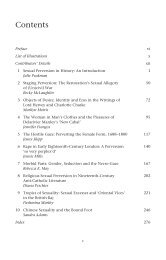The Nameless Shamelessness of Ulysses - Palgrave
The Nameless Shamelessness of Ulysses - Palgrave
The Nameless Shamelessness of Ulysses - Palgrave
Create successful ePaper yourself
Turn your PDF publications into a flip-book with our unique Google optimized e-Paper software.
<strong>The</strong> ‘nameless shamelessness’ <strong>of</strong> <strong>Ulysses</strong> 33<br />
material – in the words <strong>of</strong> an 1840 decision – containing ‘that sort <strong>of</strong> imputation<br />
which is calculated to vilify a man, and bring him into hatred,<br />
contempt, and ridicule’. 23 Holt, in his history <strong>of</strong> libel, traces the <strong>of</strong>fence back<br />
to ancient times, locating precedents in Sumerian, Greek, and Roman law<br />
before defining ‘an injury which affects [someone] in character’ as the<br />
‘next greatest injury’ after direct physical harm. 24 Within British jurisprudence,<br />
however, this otherwise straightforward conception <strong>of</strong> defamation<br />
has been considerably complicated by the development <strong>of</strong> two parallel yet<br />
distinct bodies <strong>of</strong> law regarding libel: one civil and based on common law,<br />
the other criminal and based on the rules <strong>of</strong> the Star Chamber. <strong>The</strong> crime<br />
<strong>of</strong> libel, which originally emerged as part <strong>of</strong> the government’s effort to eradicate<br />
bloody and violent duels, generated its own unique sets <strong>of</strong> rules and<br />
decisions. In a criminal case, for example, the truth <strong>of</strong> a libel cannot be<br />
employed as a defence, thus leaving the prosecutor the relatively easy task<br />
<strong>of</strong> proving that a book or article was published intentionally and contains<br />
some content potentially damaging to someone’s reputation. This rather<br />
strict limitation on the freedom <strong>of</strong> speech and publication was somewhat<br />
moderated by the passage <strong>of</strong> the Reform Act <strong>of</strong> 1843, which allowed the truth<br />
<strong>of</strong> a libel to serve as the grounds <strong>of</strong> an affirmative defence <strong>of</strong> justification<br />
if the facts revealed were deemed to be in the public interest. Oscar Wilde,<br />
who in 1895 brought a criminal charge <strong>of</strong> libel against Queensbury, finally<br />
fell foul <strong>of</strong> the courts not when witnesses emerged confirming the charge<br />
that he was a ‘somdomite’ (sic), but when it was judged that the publication<br />
<strong>of</strong> such knowledge constituted a public good. <strong>The</strong> criminal branch <strong>of</strong> defamation<br />
law therefore explicitly limits speech deemed to be damaging not to<br />
the reputations <strong>of</strong> particular individuals but to the good order and conduct<br />
<strong>of</strong> the larger society.<br />
Joyce’s bare mention <strong>of</strong> a few pubs and a railway company in Dubliners<br />
certainly did not threaten to provoke a criminal charge, particularly in<br />
the early decades <strong>of</strong> the twentieth century when additional decisions and<br />
reforms had severely limited such criminal prosecutions. Richards and his<br />
London solicitors, however, were much more concerned with the civil tort<br />
<strong>of</strong> libel which places particular burdens on defendants. As Brian Dobbs notes<br />
in <strong>The</strong> Law <strong>of</strong> Torts, in the common law, once a publication was found to be<br />
defamatory then ‘the defendant was presumed to have published in malice,<br />
the words were presumed to be false, and the plaintiff was presumed to have<br />
suffered damages’. 25 As a consequence <strong>of</strong> these far-reaching assumptions,<br />
the person or entity that had been defamed neither had to demonstrate<br />
any special damages arising from the publication or even demonstrate to<br />
a court or a jury that the material was false. 26 <strong>The</strong> truth <strong>of</strong> a libel can still<br />
serve as a defence in such a case, but the burden <strong>of</strong> proving that a defamatory<br />
comment is true shifts to the defendant. In practice, the relatively<br />
wide scope <strong>of</strong> defamation has generally been limited to particular kinds<br />
<strong>of</strong> publication which bring someone into ‘hatred, contempt, and ridicule’
















